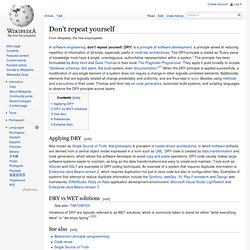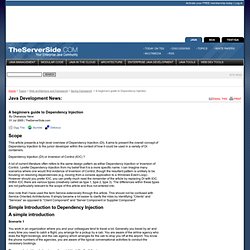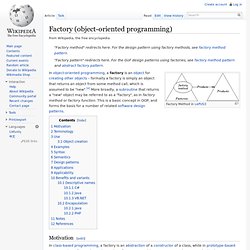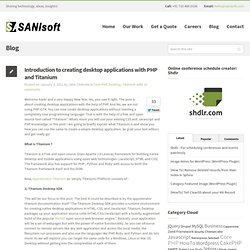

Concordion. RabbitMQ - Messaging that just works. Gearman [Gearman] Don't repeat yourself. Applying DRY[edit] DRY vs WET solutions[edit] Violations of DRY are typically referred to as WET solutions, which is commonly taken to stand for either "write everything twice" or "we enjoy typing".[2][3] See also[edit] References[edit] External links[edit]

A beginners guide to Dependency Injection. Scope This article presents a high level overview of Dependency Injection (DI).

It aims to present the overall concept of Dependency Injection to the junior developer within the context of how it could be used in a variety of DI containers. Dependency Injection (DI) or Inversion of Control (IOC) ? A lot of current literature often refers to the same design pattern as either Dependency Injection or Inversion of Control. I prefer Dependency Injection from my belief that it is a more specific name.
Also note that I have used the term Service extensively through this article. Simple Introduction to Dependency Injection. Factory method pattern. Factories may be invoked in various ways, most often a method call (a factory method), sometimes by being called as a function if the factory is a function object (a factory function).

In some languages factories are generalizations of constructors, meaning constructors are themselves factories and these are invoked in the same way. In other languages factories and constructors are invoked differently, for example using the keyword new to invoke constructors but an ordinary method call to invoke factories; in these languages factories are an abstraction of constructors but not strictly a generalization, as constructors are not themselves factories. Terminology differs as to whether the concept of a factory is itself a design pattern – in the seminal book Design Patterns there is no "factory pattern", but instead two patterns (factory method pattern and abstract factory pattern) that use factories. . # collections.defaultdict([default_factory[, ...]]) d = defaultdict(list) Inyección de dependencias. En Informática, Inyección de Dependencias (en inglés Dependency Injection, DI) es un patrón de diseño orientado a objetos, en el que se suministran objetos a una clase en lugar de ser la propia clase quien cree el objeto.

El término fue acuñado por primera vez por Martin Fowler. Historia[editar] En los comienzos de la programación, los programas eran lineales y monolíticos. El flujo de ejecución era simple y predecible, ejecutándose línea tras línea. Aparecieron dos conceptos para estructurar el código: la modularidad y la reutilización de los componentes: se crean bibliotecas de componentes reutilizables. Singleton. Su intención consiste en garantizar que una clase sólo tenga una instancia y proporcionar un punto de acceso global a ella.

El patrón singleton se implementa creando en nuestra clase un método que crea una instancia del objeto sólo si todavía no existe alguna. Para asegurar que la clase no puede ser instanciada nuevamente se regula el alcance del constructor (con atributos como protegido o privado). Las situaciones más habituales de aplicación de este patrón son aquellas en las que dicha clase controla el acceso a un recurso físico único (como puede ser el ratón o un archivo abierto en modo exclusivo) o cuando cierto tipo de datos debe estar disponible para todos los demás objetos de la aplicación.
El patrón singleton provee una única instancia global gracias a que: La propia clase es responsable de crear la única instancia.Permite el acceso global a dicha instancia mediante un método de clase.Declara el constructor de clase como privado para que no sea instanciable directamente. C#[editar]
Desarrollar software no es suficiente para ganar dinero. Marcos Eguillor #lis2012. Programación Declarativa. Introduction to creating desktop applications with PHP and Titanium at SANIsoft. Welcome back!

And a very Happy New Year. Yes, you saw it right. The post is about creating desktop applications with the help of PHP. And No, we are not using PHP-GTK. You can now create desktop applications without learning a completely new programming language! What is Titanium ? Titanium is a Free and open source (Uses Apache 2.0 License) framework for building native desktop and mobile applications using open web technologies (JavaScript, HTML and CSS).
Now, Appcelerator Titanium (or simply Titanium) Platform consists of : 1) Titanium Desktop SDK This will be our focus in this post. 2) Titanium Mobile SDK The Titanium Mobile SDK empowers you to not just create but also run and even package real native mobile application for your favorite iOS, Android and even Blackberry (still in beta) using it cross platform JavaScript APIs and the final application will actually be a native application. Titanium Developer Why would you use it. What do you need to learn ? What tools do you need ?